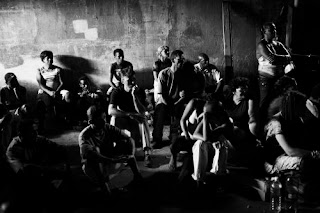
I've barely slept and I slept on the concrete floor. Vagner, took me out to check out the local discoteque, Samba Rock was the order. We decided not to go in, next week would be Funky, a hotter thrust of hips. The crowd was huge and the line must have gone down at least a kilometer. You could buy your entrance for US$7.00 but that didn't guarantee you were going to get in. It's full of young males here, probably six for every girl and you can practically smell the testosterone in the air. The girls are all out in threes, at a minimal. Some can barely keep their clothes on. It's not even hot out but in Brazil like in most of the tropics, showing flesh is a natural thing. How come the boys are wearing hoods then?

I've spotted a young couple making out. He's completely stoned, his eyes glowing like glass. She's in another state and adoring every bit of his kisses. His hands never leave her. They're making out right in front of Luis, a friend of Vagner, selling corn on the cob. Since we're all enjoying the view, I asked him how come he's not going in. He told me, as he pointed to the corn, someone's got to bring the money home. Are you married? I asked. No, no, no! How about a girlfriend? Yeah, the most beautiful girl in the world, he replied. Since I was out trying to get some research on sexuality I naturally asked him if he had sex with her. Luis was 19. He said no. I said, how come? It's too complicated he told me. Finding a place to do it is really hard out here. My house is always full and her's is impossible. Apparently they've been dating for a year and have been planning it since. I asked him if he was a virgin and he told me very quickly, no and I've only done it once. So, how was it? Very fast. I then asked him if he was planning to use a condom with his girlfriend. He paused to reflect and then said, most likely not. Why? I asked. Man, if you saw her, you'd know. She's beautiful! Any baby coming out of her would be fantastic. I then had to ask, how are you going to raise the child if your finding it so hard to make a living selling corn, have no place of your own and your girl is only 18? Ahhh, that's what out mother's are for. Irresponsible or ignorant?

I woke the next morning at 7:30 am. Vagner had to go study for his college admissions. I went round the bend in search of breakfast. I bumped into Cimar, Ze Foguete, some friends and three girls they were trying to get out into the bushes for sex. They'd all been out all night and were highly enebriated and high on coke, probably weed too. They were partying, like everyone likes to do. Recreation out here is hard to find, sex is easy to get but with little privacy, much less any intimacy, booze is around 24/7 and cheap but cocaine or crack is the word. Brazil is the second largest consumer of cocaine in the world. The drug comes through Peru, Bolivia and Colombia before it heads out to the US and Europe. Yet the dealers here don't seem to make a lot of money off of it. Some other big fish is making the money. Here, unfortunately, the dealers sell it and destroy the lives of the neighborhood as amateurs.
The girls are out dancing, strutting their stuff and the boys are out to please. Marlene is in the car, just where the boys want her to be. She's camera shy, but in the end loves the attention. I don't know what to think of it all. I know them. They're wasted, they're young and they all want action. Is it any different than the boys and girls in the upper class neighborhoods? Visually here it just looks more decadent. Yet, they certainly look more alive than the usual crowd in the discos downtown.

Cimar and Ze wanted me to join them. They told me if I wanted some dirty sexy pictures then I should go along for the ride, there would be plenty of panties to shoot. The other friends have gone. It's one girl to each man. The car has only enough gas to go there but not to come back. We're less than a kilometer away. Ze insists I come along so they can do the other girls. I tell him I'm not really interested. He gets a little pissed and calls Marta over to convince me. She approaches me half off her wits, looks me straight in the eyes with a big smile and her hands on my chest. What's the matter, don't you like me? Man!.... Sorry girl, it's none of that, your fine! I lie. I've just got business to do now.
What a lame excuse.





















































